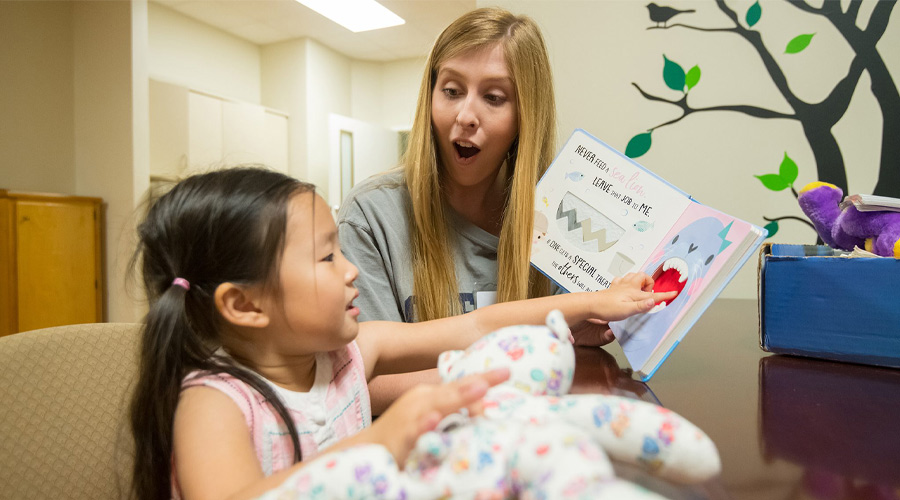Children are born with the natural ability to learn languages that their families and society use. Learning a language takes time, and each child varies in how quickly they learn language and speech skills. Growing children may struggle with some sounds, words, and sentences while understanding. However, most children can master their mother tongue and speech easily at the age of five. Parents and caregivers are vital tutors during a child’s early years in teaching language and speech skills.
Children learn language and speech by listening to others speak and adapting their tongue. But in exceptional cases, some children fail to develop the mechanism of speech articulation. This failure is labeled as a speech articulation disorder. A speech disorder is a condition in which a person has problems creating or forming the speech sounds needed to communicate with others. As a result, it can make the child’s speech difficult to understand.
At the same time, language is a set of codes, symbols, and words which help us encode minds, events, and thinking to bring out in the form of speech. Thus, children suffering from language disorders cannot communicate and understand the language. Therefore, some children must also work on harmonizing this skill to express their ideas and thoughts. This blog discusses different types of speech and language disorders and their causes.
Common Speech Disorders
Some common speech disorders are articulation disorders, phonological disorders, oral inaccuracy, voice disorders, and resonance disorders. Speech disorders can be somewhat dissimilar from language disorders in children. Language disorders characterize the inability to convey meaning or message to others and decode the message from others. Speech disorders have different names, but they are identified with similar symptoms and inabilities.
Articulation Disorder
Children suffering from articulation disorder find it difficult to make clear sounds. They cannot make certain sounds that make the word complete. For example, if they are trying to say school, they can only say “coo” instead of “school.” These errors render speech difficult to understand for people.
Phonological Disorders
In this situation, children do not compose speech sounds clearly to form the words as expected for their age. Those who suffer from this disorder leave out or skip the first or last words, most specifically consonants, while speaking. The child may have no problem pronouncing the same sound in other words, such as a child may say “boo” for “book” and “pi” for “pig” but may have no difficulty saying “key” or “go.”
Voice Disorders
Other speech disorders include harsh and husky voices with a grating sound, changes in pitch, a sudden break in and out, running out of air during the speech, etc. All of these speech disorders are related to the defectiveness and deformity of the sound articulation system. These voice disorders deform the entire speech and make it hard for its listeners to understand what a child is trying to say.
Mental And Genetic Causes
Speech is one of the unique traits of human beings. It develops as a child grows and observes people around it. The child observes the sounds, develops an understanding of them, and tries to mimic them and articulate them. But some children don’t have this natural capability to learn and develop the natural articulation mechanism. In preschool-age children face this difficulty in which they find it difficult to make certain sounds. Sometimes they have disfluencies in which they repeat the same sound. Causes of disfluency can be genetic, emotional, or brain trauma.
Muscle & Structural Deformity
Articulation and phonological disorders are caused due to problems or changes in muscle structure and bones involved in making different sounds. This deformity may occur due to some physical accident or improper development of the sound articulation mechanism. Sometimes the damage of cerebral palsy is responsible for controlling the muscles used to create speech and is the main reason that causes articulation disorders in children.
Physical Ailments
There are various ailments that disrupt normal speech and sound articulation mechanisms. If there are structural deformities in your throat, a cleft palate, nasal blockage, or lips deformity, the sound articulation disorder is likely to occur in children. In the case of a cleft palate, the air gets leaked through the nose, making sound articulation difficult for children. Due to this, sound becomes nasalized and ineffective. Sometimes laryngeal defects, a tissue that connects vocal cords together, render sound articulation ineffective and unclear. This birth defect makes a person unable to create clear sounds.
Conclusion
We have gathered some of the most important speech articulation disorders some children go through in the early stages. We have also mentioned some core causes and reasons behind these disorders to clarify the reason behind them. Identifying these causes and deformities is important because most of them are curable. If you observe any speech disorder among your children, then make sure you take them to a professional before it gets too late. Early treatments will help your child outgrow different types of speech disorders. An expert speech therapist can easily and effectively address speech disorders. So don’t be overly concerned when you find that your child has some kind of speech articulation disorder. Just get your child to an expert, and things will become easier for them.




